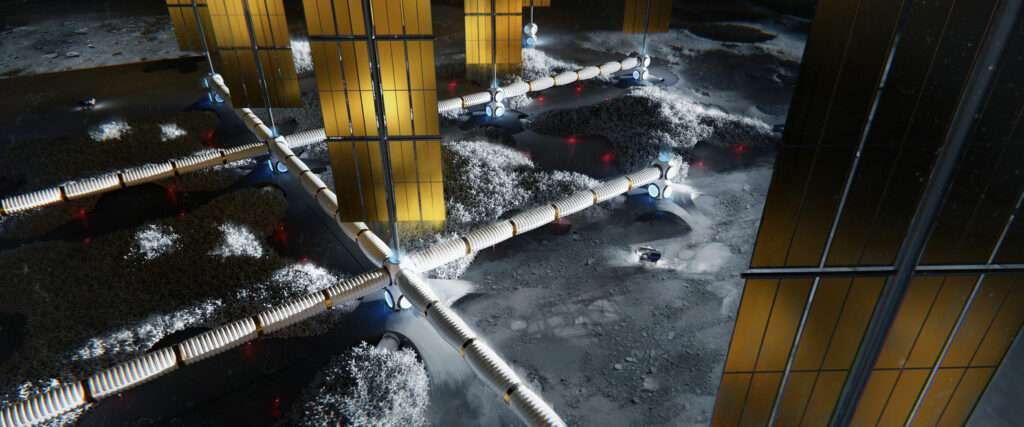Space exploration is no longer a novelty, but it continues to take steps that could make real all those aspirations that used to be fictional, such as the possibility of life on Mars. Studies carried out so far don’t completely rule out the possibility of life on another planet. A study published in the journal Nature indicated the discovery of elements that potentially prove the existence of life on that planet.
Meanwhile, the most positive signs point to the exploration of the Moon and there is already talk of human settlements. Hassell recently launched the Lunar Habitat Masterplan, a revolutionary new concept designed in collaboration with the European Space Agency (ESA) and the University of Crandfield, to support the development of the world’s first lunar habitat, i.e. an infrastructure where people can live permanently on the moon.
Working with anthropologists, psychologists, roboticists and astronauts, the concept announced by Hassel for the Lunar Habitat Masterplan considers “not only the essential elements that make a habitat habitable, but also how we can create a thriving permanent community for almost 150 people in reduced gravity”, the statement said.
“The Moon is an extremely hostile place to live. With no atmosphere, humans need innovative infrastructure to access water and oxygen, while being subjected to high levels of radiation. We need to start planning how larger communities can not only survive, but thrive and live on the moon,” says Xavier De Kestelier, Head of Design at Hassell, quoted by Archdaily.
The proposed lunar settlement was selected for its proximity to two bodies of frozen water: the Lunar South Pole and the Shackleton Crater. These resources and continuous sunlight are considered necessary for a sustainable way of life in the overall scheme.
The concept aims to break with conventional ideas for lunar settlements by utilising a 3D-printed modular system that takes inspiration from tetrapods, commonly used in wave dissipation structures. The hexapod-shaped pieces fit together to create a radiation-resistant shell, overcoming the difficulties of building on moons and their specific gravities. By allowing components to be regenerated on site, the use of lunar soil as a material for 3D printing encourages the emergence of sustainable construction.
Innovative nesting mechanisms are used in Hassell’s habitat system, allowing flexible construction to accommodate future settlements. This construction method, made possible by digital simulations, aims to maximise the use of the hexapods’ embodied energy.
This project is a conceptual study, but it begins to address the big questions about what it would take to build an adaptable, long-term lunar habitat, and imagines what that might actually look and feel like for the humans who live and work there. It’s a long way before something like this is actually built.
This isn’t the first architectural project to create communities on the moon. In 2022, it was announced that NASA and AI Space Factory had developed LINA (Lunar Infrastructure Asset), a 3D-printed outpost to protect astronauts on their critical missions on the Moon.
Another housing project on the moon was presented in 2021 at the 17th Venice International Architecture Biennale by Skidmore, Owings & Merrill (SOM) architects, called “Life Beyond Earth“, an intervention that depicts a village on the moon. The installation presents a proposal for a sustainable ecosystem that aims to enable human presence on the moon, exploiting the opportunity to expand the scope of architecture.
Life outside the Earth
One question that accompanies all debates on space issues is whether life beyond Earth is possible. And there are several answers to this question, with experts taking habitation on other planets for granted.
The scientist Alan Stern was one of the most categorical on the subject when asked if it would ever be possible for us to live off the earth. “Alan Stern: “In the next 300 years, it’s likely that more people will live in space than on Earth. I’m convinced that yes, people will leave Earth and live on these other planets. We’re really at the beginning of the principles of leaving the cradle of the Earth and moving into space and to the planets. Not just to explore them, but to have new places and new resources for human beings, to improve the quality of life for all human beings. The big picture vision is a billion humans living in the entire solar system. And we know that the Earth can’t handle it, but the solar system is so vast that it’s easy to do.” The US scientist who was responsible for the space mission to Pluto told the newspaper in an interview with Público (in Portuguese).
At the end of 2024 NASA will send the Artemis lunar rover, the Volatiles Investigating Polar Exploration Rover (VIPER), which will explore the Moon’s relatively close but extreme environment in search of ice and other potential resources. The mobile robot will land on the Moon’s South Pole on a 100-day mission. The information obtained will teach about the origin and distribution of water on the Moon and help determine how the Moon’s resources can be harvested for future human space exploration.



